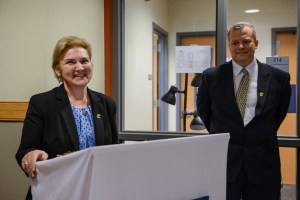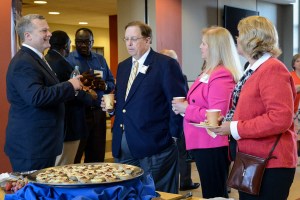 More than 10,000 bridges need to be replaced in the United States. They’re mostly made from concrete, a popular building material that has a reputation for freezing, thawing, and cracking.
More than 10,000 bridges need to be replaced in the United States. They’re mostly made from concrete, a popular building material that has a reputation for freezing, thawing, and cracking.
A researcher at The University of Tennessee at Chattanooga is examining the sustainability, durability, repair, and life cycle of concrete. He is testing ways to make it last longer so that it does not have to be replaced as frequently.
Brent Rollins is working in a new research laboratory, outfitted with a collection of instruments not found at many higher education institutions in the United States. He has been conducting research in mixing concrete with biomass (recyclable plant material) and caught the attention of Dalton B. Holmes, who has generously providing the funding for the new lab where Rollins works.
Rollins explained that working biomass into concrete isn’t a new practice—ancient civilizations combined straw into the mix of rock and sand to create building material. The new twist is finding a way to make biomass concrete work in a modern construction environment. The need is urgent, considering the limited supplies of quality aggregates are rapidly being depleted.
The new Dalton B. Holmes Long Term Durability Concrete Research Lab was dedicated on Tuesday, September 30, to promote education, research, discovery and innovation.
“I went on a tour yesterday with Brent—of the lab, and of the building, and of the campus. He really expressed a passion for UTC and for his work. As a donor, I think that’s extremely important, that I feel like my gift has made a difference in his work—in what he can do, and will do,” Holmes told a group who attended the dedication. “I feel this gift will be truly be appreciated, and hopefully, a lot of good things will come from it.”

Lynda Horsley; Dalton B. Holmes; Chancellor Steve Angle; Elizabeth Holmes; Jim Holmes; Betty Richardson
The petrography lab is located in room 214A in the Engineering, Math, and Computer Science Building on the UTC campus.
Rollins explained that part of the lab is dedicated to the microscopic study of concrete. Two microscopes are attached with a digital camera to a computer monitor. Software allows new or old concrete to be precisely measured for permeability.
“Concrete’s design life is very dependent upon its ability to resist the ingress of water and associated pollutants. The study of the pore space within the concrete is a very important indicator of concrete quality,” Rollins explains.
Abrasion resistance testing will also paint the picture of how concrete holds up under turning tires.
Rollins will be responsible for conducting most of the research with assistance from graduate students. Both Chancellor Steve Angle and Dr. Neslihan Alp, Interim Dean of the College of Engineering and Computer Science, spoke at the dedication about this hands-on opportunity for students, saying it is a “terrific experience” for students to be able to apply knowledge and prepare for a career in “the real world.”
Rollins shared the news that one chemical engineering master’s thesis will be focused on the research being conducted in the lab.




Mr. Rollins may be interested in a small-scale timber-frame and cob shed project built near the campus, behind 1025 E 8th St, visible from the alley between 8th & McCallie. The structure has 4″ timber frame, with walls made from bamboo lattice, straw/clay cob, and sand/clay/manure/cattail plaster. This commenter was the “mud man” for the project.